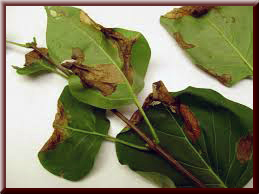Throughout the spring and summer we have watched the increase in fungal and bacterial diseases all across the  Denver Metro Area. High incidences of Bacterial Leaf Scorch in Ash trees have caused significant leaf drop and branch dieback. Fire Blight has infected Apple and Crabapple trees in every community without regard to age or variety. Just this past week I visited a property with 4 lilac bushes all severely infected with Lilac Bacterial Blight. Our Arborists have visited numerous properties to find foliar leaf spot disease in Maples, Cottonwoods, Plums, Apples, Crabapples, Aspen, and Roses.
Denver Metro Area. High incidences of Bacterial Leaf Scorch in Ash trees have caused significant leaf drop and branch dieback. Fire Blight has infected Apple and Crabapple trees in every community without regard to age or variety. Just this past week I visited a property with 4 lilac bushes all severely infected with Lilac Bacterial Blight. Our Arborists have visited numerous properties to find foliar leaf spot disease in Maples, Cottonwoods, Plums, Apples, Crabapples, Aspen, and Roses.
Many people have already noticed the early leaf drop as a result of fungal leaf diseases like leaf spot. This will continue through September and become even more pronounced as the nighttime temperatures drop. These foliar infections have already gone through their life cycle and now will overwinter on the tissue they destroyed. It is important to perform a thorough yard cleanup to help prevent new infections next spring. The weather conditions of this spring and early summer were the major factor in the high occurrence of many leaf diseases. Preventative fungicide applications during the infection period are helpful in protecting newly developing leaf tissue in the spring. These applications need to be done during the entire infection period, or until new tissue has developed the waxy cuticle that provides a measure of natural protection.
The bacterial diseases are a bit more difficult to treat and prevent. Most bacterial diseases like Fire Blight are prevalent in the environment and are simply waiting to find a suitable pathway to enter a host. This occurs frequently during springs that have multiple hail storms, causing branch and twig injuries. These wounds are a perfect route of entry. Once an infection occurs then a variety of treatments can be considered as part of a recovery program. Properly timed pruning can reduce the amount of infection that overwinters in the vascular system of the trees. Foliar treatments in spring with a fungicide/bactericide can limit new infections from starting. Trunk injections of antibiotics can therapeutically reduce the internal spread of the disease. It is important to meet with your Arborist when deciding what steps should be taken to help in the recovery of your trees.
Obviously we can’t predict what the weather conditions will be like next spring, but we can be prepared. This preparation begins this fall with proper pruning and fall yard cleanup. Further steps can be taken by making sure your Plant Health Care program includes the necessary measures to give your plants the best chance to thrive all season long.
Tree Service in Colorado Springs: 719.444.8800 or click here »
Tree Service in Denver: 303.232.0666 or click here »
